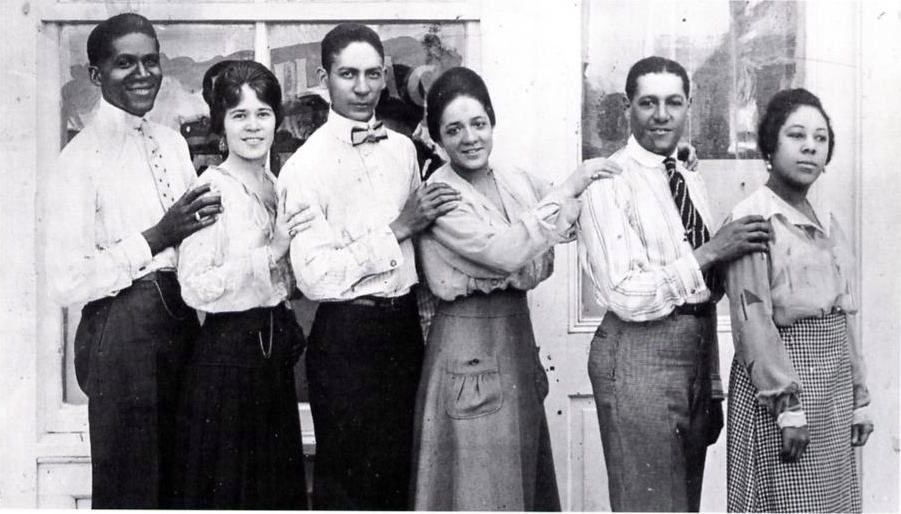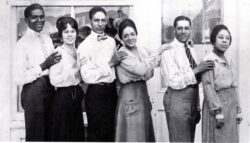Summer 2007
Inventing Jazz
Big talker Jelly Roll Morton exaggerated—but not much
Published: October 3, 2022
Last Updated: October 3, 2022

Photographer Unknown
Photograph of musicians and entertainers in Los Angeles, California, at the Cadillac Club, c. 1917 or 1918. From left to right, "Common Sence" Ross, Albertine Pickins, Ferd "Jelly Roll" Morton, Ada "Bricktop" Smith, Eddie Rucker, Mabel Watts.
But his is a career that has been saddled with controversy, especially because of remarks regarding his heritage made to Alan Lomax in a series of interviews done at the Library of Congress in 1938. As one might guess from his birth name, Morton was born a Creole of color in New Orleans, but he told Lomax that “all my folks came directly from the shores of France,” which some took to mean that he was denying his Black ancestry. As it happened, his people came to New Orleans from Haiti, but it should be pointed out that under the laws of French colonial administration, all possessions of France were considered to be France, so Morton wasn’t really stretching the truth that much after all.
Actually, Morton is an Anglicization of his step-father’s surname—Mouton—because Jelly didn’t like being called “Frenchy.” Where did the “Jelly Roll” come from? Not the pastry shop, I can assure you. Sponge cake and jelly—let’s just say it’s a euphemism and leave it at that. Oh, you don’t want to leave it at that? Then I can tell you it can be a male or a female euphemism, depending on your orientation: Jelly got the nickname from working in brothels in Storyville and from years spent traipsing around the Black vaudeville circuit. He used his name like a calling card—when Jelly Roll Morton came to town, everybody knew about it. And if you forgot, he was usually on hand to remind you.
After 1907, when he hit 17, Morton traveled all over the United States, and even spent a little time in Vancouver and Tijuana, looking for inspiration and collaborators to form the perfect jazz band. His first published composition was “The Original Jelly Roll Blues,” distributed by Will Rossiter in Chicago in 1915, but it was a series of recordings made in the Windy City a decade later that made him a jazz legend, because he finally got it right with the Red Hot Peppers (after 20 years of trying), a studio band that turned out one masterpiece after another from 1926 through 1929. His recordings of songs like “Black Bottom Stomp,” “Jungle Blues,” “Grandpa’s Spells,” “The Pearls,” and “Doctor Jazz” (a tune by his friend Joe Oliver) took New Orleans jazz to the next level. Morton’s vision of jazz was holistic; he gave it a brilliance and polish that had been lacking and achieved a coherence that was both personal and universal. Yet, financial success continued to elude him. In 1927, Music Corporation of America signed Morton, but Karl Kramer, his handler, didn’t have any idea of who he was. While Morton was turning out “hot” masterworks for Victor, white America was looking for “sweet” bands, and MCA’s attempts to organize tours for Morton were mostly disasters.
Morton moved to New York City a year later, where he decided to take matters into his own hands. He waited for Luis Russell’s New Orleans band to go on vacation and then paid Russell to stay home while he took the band on tour. After two weeks, prospective clients were told that his calendar was full and he would not be available for a year. That’s one way to create demand, but not a very effective way to supply it. New York musicians resented Morton because he was always bragging about how he invented jazz. In 1931 Victor dropped him from their recording roster, and the Depression took its toll. Soon Morton was living in obscurity in Washington, DC, working in a dive called the Jungle Inn, where he alternated between playing the piano and sweeping up. Then came a reversal of fortune. When Morton learned that Alan Lomax was conducting interviews at the Archive of American Folksong in 1938, he decided to crash the party, leading to the first jazz oral history ever done. In 1939 the authors of Jazzmen, a history of jazz published in that year, persuaded officials at RCA Victor to record Morton again, with homeboys Red Allen on trumpet, Sidney Bechet and Albert Nicholas on reeds, and Zutty Singleton on drums. Nicholas remembered Jelly Roll scolding Singleton for being too loud, insisting that he play at a reasonable volume, “so the musicians can be heard.” (That’s right, take it out on the drummer!) Morton began writing letters to Ripley’s Believe It or Not and Down Beat, claiming that he alone had invented jazz, and a full-fledged comeback seemed to be in the making. But a trip to California in the winter of 1940 to get yet another fresh start was to be his last. He died in Los Angeles from cardiac arrest on July 10, 1941. Kid Ory was a pallbearer at the funeral and overheard someone lamenting the lack of a brass band to send Morton off in style. His purported response was, “We’ll do it next time.”
In the late 1980s, there was one last comeback. George C. Wolfe’s musical Jelly’s Last Jam, starring Gregory Hines, took Broadway by storm, returning Morton to public attention in a big, if not always flattering, way. I understand that people leaving after the show were making comments like, “That Jelly Roll Morton wasn’t much of a musician, but he sure could dance!” Well, don’t be surprised. In jazz history, like the theater, you’re only as good as your last review. But what you do on the bandstand is yours to keep, and as Morton said in his Library of Congress interview: “Pardon me for creditin’ myself, but you got to do it occasionally.”
Bruce Boyd Raeburn, PhD, is a former director of the Hogan Jazz Archive at Tulane University.
